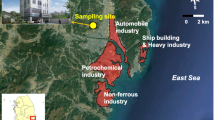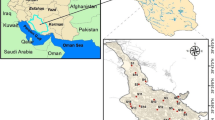Abstract
Sixty atmospheric sample concentrations of PM2.5 and polycyclic aromatic hydrocarbons (PAHs) in PM2.5 were analyzed in distinct seasonal variations from a classic agglomeration industrial city. The concentrations of PM2.5 ranged from 6.96 to 260.06 μg/m3 with an average of 177.05 μg/m3. Only 38% of the sampling days were superior to the 24-h limit value (75 μg/m3) of ambient air quality standards (AAQs), and the samples from autumn and winter exceeded the limit value. The total PAHs ranged from 1.51 to 44.51 ng/m3 with an average of 10.65 ng/m3. The highest and lowest concentrations of total PAHs appeared in winter and summer with averages of 22.56 and 4.03 ng/m3, respectively. Correlation analysis revealed that high-molecular-weight PAHs (HMW-PAHs) (4-, 5-, 6-ring PAHs) were significantly and negatively correlated with temperature and water-soluble total organic carbon (WTOC), and significantly correlated with water-soluble total nitrogen (WTN). The 4-, 5- and 6-ring PAHs were dominant, especially those of 4-ring PAHs, which were above 30% of the total PAHs in each season. Source apportionment indicated that PM2.5-bound PAHs in Huangshi were mainly derived from pyrogenic source, vehicle exhaust, coal combustion, and biomass burning. Incremental lifetime cancer risks (ILCRs) showed no potential carcinogenic risk from the PM2.5-bound BaP-eq. ILCRs in winter were the highest, and the risks for adults were approximately an order of magnitude higher than those for children.






Similar content being viewed by others
References
Augusto S, Máguas C, Matos J, Pereira MJ, Branquinho C (2010) Lichens as an integrating tool for monitoring PAH atmospheric deposition: a comparison with soil, air and pine needles. Environ Pollut 158:483–489
Bandowe BA, Meusel H, Huang RJ, Ho K, Cao J, Hoffmann T et al (2014) PM2.5-bound oxygenated PAHs, nitro-PAHs and parent-PAHs from the atmosphere of a Chinese megacity: seasonal variation, sources and cancer risk assessment. Sci Total Environ 473-474:77–87
Bari MA, Baumbach G, Kuch B, Scheffknecht G (2010) Particle-phase concentrations of polycyclic aromatic hydrocarbons in ambient air of rural residential areas in southern Germany. Air Qual Atmos Health 3:103–116
Beyer A, Wania F, Gouin T, Mackay D, Matthies M (2003) Temperature dependence of the characteristic travel distance. Environ Sci Technol 37:766–771
Blaszczyk E, Rogula-Kozlowska W, Klejnowski K, Fulara I, Mielzynska-Svach D (2017) Polycyclic aromatic hydrocarbons bound to outdoor and indoor airborne particles (PM2.5) and their mutagenicity and carcinogenicity in Silesian kindergartens, Poland. Air Qual Atmos Health 10:389–400
Callen MS, Iturmendi A, Lopez JM (2014) Source apportionment of atmospheric PM2.5-bound polycyclic aromatic hydrocarbons by a PMF receptor model. Assessment of potential risk for human health. Environ Pollut 195:167–177
Chen F, Hu W, Zhong Q (2013) Emissions of particle-phase polycyclic aromatic hydrocarbons (PAHs) in the Fu Gui-shan Tunnel of Nanjing, China. Atmos Res 124:53–60
Chen SC, Liao CM (2006) Health risk assessment on human exposed to environmental polycyclic aromatic hydrocarbons pollution sources. Sci Total Environ 366:112–123
Chen Y, Li X, Zhu T, Han Y, Lv D (2017) PM2.5-bound PAHs in three indoor and one outdoor air in Beijing: concentration, source and health risk assessment. Sci Total Environ 586:255–264
Correia AW, Pope CA, Dockery DW, Wang Y, Ezzati M, Dominici F (2013) Effect of air pollution control on life expectancy in the United States an analysis of 545 US counties for the period from 2000 to 2007. Epidemiology 24:23–31
Decesari S, Facchini MC, Fuzzi S, Tagliavini E (2000) Characterization of water-soluble organic compounds in atmospheric aerosol: a new approach. J Geophys Res-Atmos 105:1481–1489
EU (2008) Directive of the European Parliament and of the Council on Ambient Air Quality and Cleaner Air for Europe. European Union. http://ec.europa.eu/environment/air/quality/standards.htm. Accessed 8 January 2018
Fraser MP, Cass GR, Simoneit BR, Rasmussen R (1997) Air quality model evaluation data for organics. 4. C2-C36 non-aromatic hydrocarbons. Environ Sci Technol 31:2356–2367
GB3095-2012 (2012) National Ambient Air Quality Standards in China. Ministry of Environmental Protection and General Administration of Quality Supervision, Inspection and Quarantine of the People’s Republic of China. http://kjs.mep.gov.cn/hjbhbz/bzwb/dqhjbh/dqhjzlbz/201203/t20120302_224165.shtml. Accessed 8 January 2018
Geng NB, Wang J, Xu YF, Zhang WD, Chen C, Zhang RQ (2013) PM2.5 in an industrial district of Zhengzhou, China: chemical composition and source apportionment. Particuology 11:99–109
Günther T, Dornberger U, Fritsche W (1996) Effects of ryegrass on biodegradation of hydrocarbons in soil. Chemosphere 33:203–215
Hu TP, Zhang JQ, Ye C, Zhang L, Xing XL, Zhang Y et al (2017) Status, source and health risk assessment of polycyclic aromatic hydrocarbons (PAHs) in soil from the water-level-fluctuation zone of the three gorges reservoir, China. J Geochem Explor 172:20–28
Karar K, Gupta AK (2006) Seasonal variations and chemical characterization of ambient PM10 at residential and industrial sites of an. Urban region of Kolkata (Calcutta), India. Atmos Res 81:36–53
Khalili NR, Scheff PA, Holsen TM (1995) PAH source fingerprints for coke ovens, diesel and, gasoline engines, highway tunnels, and wood combustion emissions. Atmos Environ 29:533–542
Khan MF, Latif MT, Lim CH, Amil N, Jaafar SA, Dominick D, Mohd Nadzir MS, Sahani M, Tahir NM (2015) Seasonal effect and source apportionment of polycyclic aromatic hydrocarbons in PM2.5. Atmos Environ 106:178–190
Kim KH, Kabir E, Kabir S (2015) A review on the human health impact of airborne particulate matter. Environ Int 74:136–143
Lai IC, Lee CL, Zeng KY, Huang HC (2011) Seasonal variation of atmospheric polycyclic aromatic hydrocarbons along the Kaohsiung coast. J Environ Manag 92:2029–2037
Larsen RK, Baker JE (2003) Source apportionment of polycyclic aromatic hydrocarbons in the urban atmosphere: a comparison of three methods. Environ Sci Technol 37:1873–1881
Lee JY, Shin HJ, Bae SY, Kim YP, Kang C-H (2008) Seasonal variation of particle size distributions of PAHs at Seoul, Korea. Air Qual Atmos Health 1:57–68
Leitte AM, Schlink U, Herbarth O, Wiedensohler A, Pan XC, Hu M et al (2011) Size-segregated particle number concentrations and respiratory emergency room visits in Beijing, China. Environ Health Perspect 119:508–513
Li X, Kong S, Yin Y, Li L, Yuan L, Li Q, Xiao H, Chen K (2016) Polycyclic aromatic hydrocarbons (PAHs) in atmospheric PM2.5 around 2013 Asian Youth Games period in Nanjing. Atmos Res 174-175:85–96
Liu J, Man R, Ma S, Li J, Wu Q, Peng J (2015) Atmospheric levels and health risk of polycyclic aromatic hydrocarbons (PAHs) bound to PM2.5 in Guangzhou, China. Mar Pollut Bull 100:134–143
Nisbet ICT, Lagoy PK (1992) Toxic equivalency factors (Tefs) for polycyclic aromatic-hydrocarbons (Pahs). Regul Toxicol Pharmacol 16:290–300
Niu ZC, Zhou WJ, Wu SG, Cheng P, Lu XF, Xiong XH, Du H, Fu Y, Wang G (2016) Atmospheric fossil fuel CO2 traced by Delta C-14 in Beijing and Xiamen, China: temporal variations, inland/coastal differences and influencing factors. Environ Sci Technol 50:5474–5480
Novakov T, Penner JE (1993) Large contribution of organic aerosols to cloud-condensation-nuclei concentrations. Nature 365:823–826
Panther BC, Hooper MA, Tapper NJ (1999) A comparison of air particulate matter and associated polycyclic aromatic hydrocarbons in some tropical and temperate urban environments. Atmos Environ 33:4087–4099
Rogge WF, Hildemann LM, Mazurek MA, Cass GR, Simoneit BR (1993) Sources of fine organic aerosol. 2. Noncatalyst and catalyst-equipped automobiles and heavy-duty diesel trucks. Environ Sci Technol 27:636–651
Sadiktsis I, Bergvall C, Johansson C, Westerholm R (2012) Automobile tires: a potential source of highly carcinogenic dibenzopyrenes to the environment. Environ Sci Technol 46:3326–3334
Shulman ML, Jacobson MC, Carlson RJ, Synovec RE, Young TE (1996) Dissolution behavior and surface tension effects of organic compounds in nucleating cloud droplets. Geophys Res Lett 23:277–280
Tao J, Zhang LM, Engling G, Zhang RJ, Yang YH, Cao JJ, Zhu C, Wang Q, Luo L (2013) Chemical composition of PM2.5 in an urban environment in Chengdu, China: importance of springtime dust storms and biomass burning. Atmos Res 122:270–283
Wania F, Mackay D (1995) A global distribution model for persistent organic-chemicals. Sci Total Environ 160-61:211–232
Wania F, Mackay D (1996) Tracking the distribution of persistent organic pollutants. Environ Sci Technol 30:A390–A396
WHO (2000) Air quality guidelines for Europe, 2nd ed. WHO Regional Officefor Europe, Copenhagen. http://www.who.int/iris/handle/10665/107335. Accessed 8 January 2018
WHO (2005) Air quality guidelines global update: particulate matter, ozone, nitrogen dioxide and sulfur dioxide. WHO Regional Office for Europe, Copenhagen. http://www.who.int/iris/handle/10665/107823. Accessed 8 January 2018
Xing XL, Qi SH, Zhang JQ, Wu CX, Zhang Y, Yang D, Odhiambo JO (2011) Spatial distribution and source diagnosis of polycyclic aromatic hydrocarbons in soils from Chengdu Economic Region, Sichuan Province, western China. J Geochem Explor 110:146–154
Xing XL, Zhang Y, Yang D, Zhang JQ, Chen W, Wu CX, Liu H, Qi S (2016) Spatio-temporal variations and influencing factors of polycyclic aromatic hydrocarbons in atmospheric bulk deposition along a plain-mountain transect in western China. Atmos Environ 139:131–138
Xu HM, Ho SSH, Gao ML, Cao JJ, Guinot B, Ho KF, Long X, Wang J, Shen Z, Liu S, Zheng C, Zhang Q (2016) Microscale spatial distribution and health assessment of PM2.5-bound polycyclic aromatic hydrocarbons (PAHs) at nine communities in Xi'an, China. Environ Pollut 218:1065–1073
Yang GH, Wang Y, Zeng YX, Gao GF, Liang XF, Zhou MG, Wan X, Yu S, Jiang Y, Naghavi M, Vos T, Wang H, Lopez AD, Murray CJL (2013) Rapid health transition in China, 1990-2010: findings from the global burden of disease study 2010. Lancet 381:1987–2015
Yang H, Li QF, Yu JZ (2003) Comparison of two methods for the determination of water-soluble organic carbon in atmospheric particles. Atmos Environ 37:865–870
Yunker MB, Macdonald RW, Vingarzan R, Mitchell RH, Goyette D, Sylvestre S (2002) PAHs in the Fraser River basin: a critical appraisal of PAH ratios as indicators of PAH source and composition. Org Geochem 33:489–515
Zhang F, Wang ZW, Cheng HR, Lv XP, Gong W, Wang XM, Zhang G (2015a) Seasonal variations and chemical characteristics of PM(2.5) in Wuhan, central China. Sci Total Environ 518-519:97–105
Zhang JQ, Qu CK, Qi SH, Cao JJ, Zhan CL, Xing XL, Xiao Y, Zheng J, Xiao W (2015b) Polycyclic aromatic hydrocarbons (PAHs) in atmospheric dustfall from the industrial corridor in Hubei Province, Central China. Environ Geochem Health 37:891–903
Zhang JQ, Zhan CL, Liu HX, Liu T, Yao RZ, Hu TP, Xiao W, Xing X, Xu H, Cao J (2016) Characterization of polycyclic aromatic hydrocarbons (PAHs), Iron and black carbon within street dust from a steel industrial city, central China. Aerosol Air Qual Res 16:2452–2461
Zhang YX, Tao S (2008) Seasonal variation of polycyclic aromatic hydrocarbons (PAHs) emissions in China. Environ Pollut 156:657–663
Acknowledgments
We gratefully thank Yong Zhang for collecting the sample.
Funding
The research was supported by the National Key Research and Development Program of China (2017YFC0212602), the Hubei Universities of Outstanding Young Scientific and Technological Innovation Team Plans (T201729), the Special Scientific Research Funds for National Basic Research Program of China (2013FY112700), the Outstanding Youth Science and Technology Innovation Team Projects of Hubei Polytechnic University (13xtz07), the Open Research Fund of Key Laboratory of Minal Environmental Pollution Control and Remedition in Hubei Province (201702).
Author information
Authors and Affiliations
Corresponding author
Electronic supplementary material
ESM 1
(DOCX 409 kb)
Rights and permissions
About this article
Cite this article
Hu, T., Zhang, J., Xing, X. et al. Seasonal variation and health risk assessment of atmospheric PM2.5-bound polycyclic aromatic hydrocarbons in a classic agglomeration industrial city, central China. Air Qual Atmos Health 11, 683–694 (2018). https://doi.org/10.1007/s11869-018-0575-3
Received:
Accepted:
Published:
Issue Date:
DOI: https://doi.org/10.1007/s11869-018-0575-3




